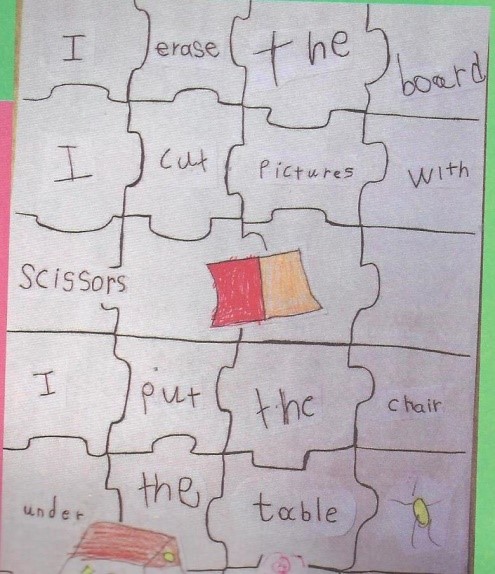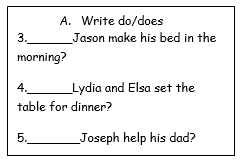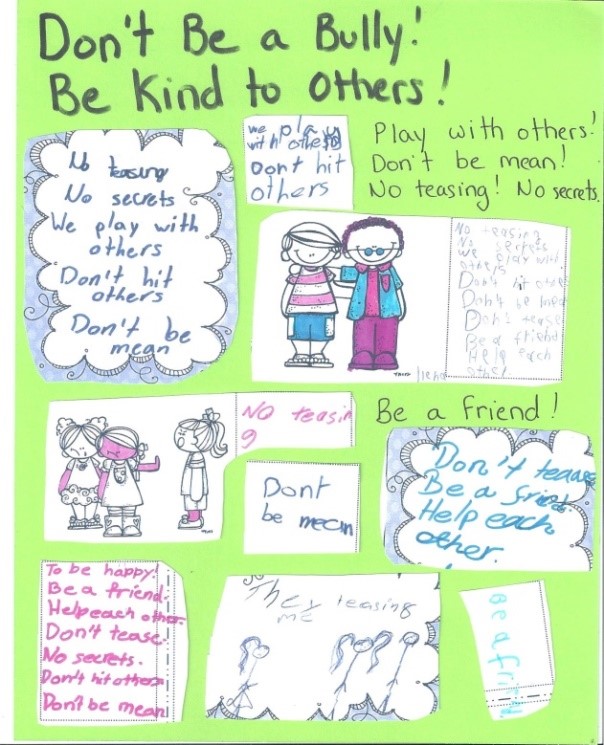Injecting Values Education into the English Curriculum of Young Learners
Eugenia P. Iskos is an English and Science teacher at Anatolia Elementary School. She holds an B.A in English, a B.S in Genetics and Microbiology and a Masters in Education. Email: jiskos@anatolia.edu.gr
Sophia E. Gegiou is an English teacher at Anatolia Elementary School, and Coordinator of the English Department. She holds an MA in Early Childhood Education. Email: sophiag@anatolia.edu.gr
Ellyze Francisco worked as an Elementary Education Fellow at Anatolia Elementary School in 2017-2018. She graduated from the City University of New York in 2014 with a BA in Spanish Literature and French Culture and is currently pursuing a Masters in Cultural Studies in Santiago de Compostela, Spain. Email: franciscoellyze@gmail.com
The teaching of English as a Second Language with respect to young learners emphasizes a communicative approach to learning. However, communicating with others inherently carries an unspoken value system by those involved. Expanding the horizons of English teaching and explicitly teaching values provides motivating factors and classroom building activities that bond students together and enhance their learning experience. This article provides an account of teachers’ personal experiences based on values projects and the teaching of values such as respect, compassion, cooperation, caring, perseverance, and lifelong learning. These values were taught through various means, by classroom discussions, using video clips and by doing individual and group projects. The school’s English newspaper (The Anatolia Sun) was the venue for exhibiting students’ work and supporting students into using these values as “tools” for a better tomorrow.
Key Words: Values Education, ELT, Early Childhood Education, Character Education
Introduction
The teaching of values has always been part of education either explicitly or implicitly (Mergle, 2008). In the distant past, parents mainly schooled children on morals and behavior. In the US, there were laws as early as the early colonial era (1642) that required parents to educate their children. What has changed in the present times is parenting and the society. In Leonard Sax’s book (2016), The Collapse of Parenting, he notes that there has been a transfer of authority where parents have given up their role as mentors for their children and have seceded that right. The child, therefore, is more prone to be influenced by other factors than parenting. In the meantime, the values in society have also changed especially in the school system. NCERT, the Department of Education in India criticizes current models of education stating,
“ This model of education puts exclusive focus on cognitive to the total neglect of the affective domain … Students are nurtured in a spirit of excessive competition and are trained right from the beginning to relate to aggressive competition and facts detached from contexts. “
Schools have also turned away from teaching more holistically towards a more academic focus. Sax (2016) notes that,
“throughout the 1980s and 1990s-and in many school districts-school administrators prided themselves on introducing “rigor” into elementary school education[…] and cutting down on the “fluff”. The change in the early elementary curriculum and the consequent neglect of teaching socialization places a greater burden than ever before on the American parent.”
Thus, there has been a movement throughout the world towards teaching values within the school systems. The Organization for Economic Cooperation and Development (OECD )in 2015 included a character assessment in its Program for International Assessment assigning more importance than ever towards creating students with better “soft skills” such as collaborating, empathy, decision making and others. Research is also taking note and is currently assessing more quantitative methods in measuring the achievement of values as seen in studies for improving emotional and behavioral performance (Durlak &al, 2011).
What is Values Education?
Values Education involves the teaching of the ideals that a “society deems important” (Department of Education (Australia), Science and Training 2005; Lovat & Toomey 2007; Robb 2008). Schools are influenced by community values, school and the classroom values (DeNobil, J & Hogan,E, 2014). These encompass the local religious teachings, school culture, curriculum, pedagogy along with the interaction of the community. Teachers thus encounter many of these influences in the classroom with consequences to their teaching. Currently, in Dubai, the Department of Education has mandated a specific moral education program (Dubai School Inspection Bureau, 2017). Teachers in other parts of the world also adhere to providing character education to the students. Yet, for most teachers according to a study by Robert Thornberg (2008), values education is “(a) most often reactive and unplanned, (b) embedded in everyday school life with a focus on students’ everyday behavior in school as a constantly ongoing informal curriculum, and (c) partly or mostly unconsciously performed by the teachers.”
In addition to values that are concrete or part of a school curriculum, Philip Jackson (1968) coined the term, «hidden curriculum that brought forth how school expectations and structure in the classroom form a subtle framework of values not evident. Teacher praise, student grouping and power plays all define hidden values within the school. Therefore, values can be tangible, but also implied in various situations that occur within the school.
Values within different education systems
The values that are desired to cultivate in schools across the globe contain many similarities. Some countries have installed specific goals within their ministries of education while others may have adopted some very general guidelines with no specific implementation schemes. The British Department for Education (August 2017) Report on Character Education mentions the cultivation of traits such as resilience, honesty, hard work, self- control, team working, leadership etc. These traits are noted as important for students’ academic future, employment and to “making positive contribution to British society.” The Australian Department of Education (2005 National Framework Report) has categorized values taught in 9 core areas such as care and compassion, doing your best, fairness, freedom, honesty, integrity etc. It has also implemented varying programs in schools to review best practices (Zbar & al, 2005). The Indian Educational system (NCERT) lays down 4 universal values: justice, liberty, equality, and fraternity with further explanations within these central lines. Depending on schools, students are inculcated into values via school projects, morning assemblies, learning to serve others through school outreach programs and more (NCERT, 2016). Japan has a complex system of moral education that aims to teach to the whole person involving the mind, heart and body. One of their tools involves the use of government-issued, values textbooks at early grades incorporating categories such as “looking at one’s self”, “together with other people”, “touching nature” and “together with everybody” (Bolton, 2015). The Japanese program involves explicit moral courses and a unique aspect such as keeping a notebook of the heart where students record responses on affective issues. However, the degree in which all these guidelines from MEXT (Japanese Ministry of Education) are implemented varies from school to school and from teacher to teacher (Bolton, 2015). In South America, universal human values are combined with involvement with the state. José Francisco Juarez (2002) of André Bello Catholic University in Venezuela writes on encouraging imagination, liberty, relationships, identity as well as participation and service within the community and the education system.
In contrast, the U.S.A has promoted character development in schools through its program, Partnerships in Character Education Program (PCEP) arising from the standards brought forth from the No Child Left Behind Act of 2001. This program awards grants to special programs designed in schools across the nation that promote values in students, but there is no systematic approach.
Despite the many similarities around the world found in the values that their respective Educational Systems aspire to, there are also differences in the rigor which they are applied. However, there seems to be a growing awareness of the need to teach fundamental human values around the globe in recent years. In a survey (April 2018) by the University of Birmingham, 80% of teachers in the UK stated that including character education in schools would improve skills needed for the workplace and improve their academic ability. Given this apparent need, it is important to gain insights into what and how it is actually taught in terms of character education and to glean what may be successful practices.
In this paper, the English department teachers of an elementary private school in Greece describe and discuss their classroom experiences with respect to the values projects that were integrated into the ELT curriculum. Their insights are described below.
Method
The English teachers of a private elementary school in Thessaloniki decided to conduct a values program encompassing grades K-6 as part of an English project for the two yearly editions of the school’s English nr magazine. The values that would be emphasized at each grade level were decided jointly according to the language level and the complexity of the value to be taught. They were as follows:
Pre-K: Being Considerate/Fairness
Kindergarten: Responsibility/Knowledge
First Grade: Working hard/accomplishment, Cooperation, Caring
Second Grade: Neatness, Kindness
Third Grade: Compassion and Friendship, Protecting the natural environment
Fourth Grade: Appreciation for the past, Role Models/Individuality
Fifth Grade: Respect for Wildlife, volunteering
Sixth Grade: Perseverance, Life-long learning
The different teachers at each grade level worked cooperatively to design the different approaches and for the development of the activities. However, teachers had a degree of autonomy varying on need and level for each classroom. Each grade level required language building lessons before classroom discussions of the values and activities. Grade 1 involved learning initially verbs that involve classroom activities such as write, erase, clean and speak in order to elicit examples of working hard. Grade 2 had to be pre-taught present simple to be able to discuss examples of kindness performed by them towards friends and family members. Higher grades demanded more vocabulary to be able to understand more complex topics such as perseverance and life-long learning.
The values were not taught in a direct manner, but in a dialectical-interactive method where students guided by the teacher arrived at what they deemed were examples of the values (Research for CULT). Some of the teachers expanded their teaching of values to other facets of their curriculum. When giving examples of activities, a picture showing a child excluded from a game brought up discussions and reminded students of previous teaching. Joint projects with the IT teacher were also conducted with respect to the value of respecting the environment and showing compassion by using “The Giving Tree” (Silverstein, 1964). Therefore, values were also embedded into worksheets and daily activities that the teachers created for their classes.
Information on the projects was provided by discussions and anecdotal notes from the teachers that conducted the teaching. They were also collected with respect to a written questionnaire.
Results
The teaching of values that initially started as a newspaper project of the English department expanded beyond the original project for some teachers. They created additional activities in the classroom. There was also a realization that some values were already being taught within the class albeit not as consciously especially with daily activities that pertain to being responsible for their behavior, for their personal items and for the cleanliness of the classroom. Many teachers already had students manage classroom materials such as scissors, markers and books, but now the activities became more systematic.
The teaching of values to young learners of English required a step-by-step approach. Initially, the language necessary to be able to communicate the respective values had to be developed such as verbs like clean, do and make for activities in first grade. Modeling played an important part in initiating speaking and written communication on values. When the teacher referred to her own experiences on how she works hard at home saying, “I mop the floor at home.” students were able to expand with their own ideas such as, “I erase the board.”, “I do homework.” Children, irrespective of age, were able to express orally and in written form their experiences on values. They wrote cooperatively within groups about how hard they work and created posters (1).


They cooperatively created written papers describing volunteer groups or how they can display kindness (2, 3). The more conscious effort of teaching projects as part of the newspaper scheme prompted some teachers to interweave the teaching of values into their curriculum or to make students aware of positive behaviors. Teacher-made worksheets (3) started to include references to values. In one such example, in the teaching of present simple, the sentences also included good models of chores that students can do at home or as reinforcement to show kindness to others.


Teachers also became more conscious of images that they used when conducting classroom lessons that could provide awareness of issues such as bullying or behavior towards others. One of the visuals (5) that a teacher displayed for usage of present continuous had a group of students swimming and one student was alone on the side.

This encouraged one student to discuss her problem of exclusion in the playground, allowing feelings to surface and addressing the problem in the classroom. The teacher involved mentioned that this prompted a lot of students expressing problems that may not have been brought to her attention otherwise. Although time was taken away from using more grammar examples, bringing this issue up in class and having students learn how to communicate their feelings of exclusion and manage similar situations is also an important part of school.
Additionally, there was expansion on some projects with other teachers of different disciplines. For example, a project on the environment discussing the book, “The Giving Tree” (Silverstein, 1964), was illustrated in the IT classroom by the students with students highlighting the important environmental concerns that the book raises.
Effect on Students and Teachers
The greatest impact in some of the classrooms that the more conscious teaching of values had was on the atmosphere of the class. Many students were more open to discussing personal issues in the classroom or out in the yard. They became more aware of behaviors. Some students also were happy to share that they helped their mom at home with cleaning or setting the table. It created a pride in these positive behaviors. Students reveled in finding that they had common ground in how they did chores at home and in how they showed kindness towards their grandparents
This surfacing of emotions and communication of our values built a warmer environment in class and allowed student to better work in groups and improved classroom behavior (Brackety et al., 2011)
Some of the simple ways to keep a positive classroom were having students use polite words and creating classroom routines such as helping to pass out books, working cooperatively in groups and assisting others in the classroom. These simple tasks as well as praise given to specific behaviors conveyed a sense of achievement in the children and reinforced good habits even into the following year. Evelyn Soto (2014) in her thesis on Behavior Specific Praise (BSP) also noted that highlighting specific positive behaviors in class creates better communication within peers and toward teachers.
The greater the involvement of students in classroom discussions about bullying and being kind, the more prone students were to voice concerns and problems that they had with others. Thus, problems that may fester under the surface become exposed and are addressed. Students more openly expressed their frustrations over having other students talking about them negatively, keeping secrets or not playing the games that they want during recess.

There were other more daily improvements to the classroom environment. By teaching classroom cleanliness, students tidied up the classroom, passed out and put materials back into their places and acquired more organization and respect for their classroom. This made for a more efficient classroom, so that the amount of on task activities in learning English was maximized.
Another effect of opening the classroom to discussions on values in such things as chores around the house or how we show our love towards our family was that students wanted to speak more in their English class. There was the occasional use of the first language, but overall there was more enthusiasm in class. The use of language also took a more natural context rather than typical activities utilized in textbooks or other more stylized discussions.
Discussing values in class produced an improvement in how students communicated and behaved towards each other. Students were more patient to wait their turn and to work together in groups. However, there were still instances where children had to be reminded to behave appropriately and to use English. Learning and sharing experiences in class helped built relationships between students. Students played with each other outside class when they became more familiar with each other. They were also more apt to share material to work together such as pencils, scissors or markers.
As some teachers exerted a more conscious effort to create opportunities to bring values into their students’ lives there was a realization that curriculum can be adjusted to reflect them along with the ELT learning objectives of the lessons. When creating a worksheet the choice of the content in the sentences can be geared to show positive behaviors and habits. There is teacher autonomy in choosing the images that are displayed on a slideshow when going over vocabulary or tenses. Some images can have students thinking of issues that they encounter. As English teachers, literature books are often used in class and the content of these can also be chosen to complement the values of the age group that is being taught. Books that talk about behavior such as, “I have a little problem,” said bear” (Janisch, 2012), had students talking about their own problems and were sensitized to understand that disruptive behaviors hurt the class and the teacher in the end. The extent to how much time each teacher expended on values also depended on the rigor of the ELT curriculum. There are expectations to meet the demands of examinations at higher levels so it may be harder for teachers to spend time with a more comprehensive approach to character education. There were also teachers who felt that despite their teaching of values, the parents have the greatest impact on their children. Regardless of the awareness the students received in class concerning behavior, if values weren't reinforced at home, it became redundant.
Conclusions
The time that students spend with their families has decreased in relation to the past. In a UK 2017 study by Bright Horizons, parents spend more time at work than in the past and have less time with their children. Students spend more time with their teachers than their parents on a daily and weekly basis. This is true for schools in Asian countries where schooling is taking up more hours per day than in the past. (Hong Kong Research Office, 2018). The school environment has also changed worldwide and not just academically, but also in terms of a rise in violent incidents such as school shootings in the USA, bullying (CDC, 2018) and student suicides in Japan. There is perhaps a greater need for teachers to be more consciously aware of their role of imbibing values to young people as they may now spend more time with young people than their families do. The teacher experiences in the program showed that despite the use of a foreign language, values can be taught provided the teacher has prepared the students for the use of vocabulary and syntax. Most importantly, values provide a sounding board for discussion in the classroom and a much closer knit group of individuals that has resounding benefits. There seemed to be a need for the children to have a safe environment provided by the teachers where their feelings and ideas would be listened to and respected and given support. This was probably the most important outcome of the whole experience.
Bibliography
Arthur, J. (2016) Convergence on Policy Goals: Character Education in East Asia and England. Journal of International Comparative Education, vol. 5, no. 2.
Bolton, K. H. (2015) Moral Education in Japan: The Coming of a New Dawn, Abe’s New Moral Education, UNIVERSITETET I OSLO Masters Thesis.
Brackett, M.A., Reyes, R., Rivers, M., Elbertson, N., Salovey, P.(2011) Classroom Emotional Climate, Teacher Affiliation, and Student Conduct. Journal of Classroom Interaction, V 45(1) pgs. 27-36.
Center of Disease Control (2018) School Violence : Data and Statistics https://www.cdc.gov/violenceprevention/youthviolence/schoolviolence/data_stats.html [ Accessed July 9, 2018]
DeNobile,J,&Hogan,E. (2014) Values education: what, how, why and what next?, Curriculum and Leadership Journal, 12 (1)
Dubai School Inspection Bureau (2017) School Inspection Supplement , Knowledge and Human Development Authority pg. 9
Durlak, J. A., Weissberg, R. P., Dymnicki, A. B., Taylor, R. D. & Schellinger, K. B. (2011). The impact of enhancing students’ social and emotional learning: A meta-analysis of school-based universal interventions. Child Development, 82(1): 405–432.
Hong Kong Research Office Legislative Council Secratariat (2018) Overall study hours and student well-being in Hong Kong https://www.legco.gov.hk/research-publications/english/1718in05-overall-study-hours-and-student-well-being-in-hong-kong-20180130-e.pdf [ Accessed July 2018]
Janisch, H. (2012) I Have a Little Problem, Said the Bear. Leffler, S. NorthSouth Books.
Jackson, P (1968) Life in Classrooms. Holt, Rinehart and Winston pgs 33-37
Juarez, J. F. (2002) HACIA UNA EDUCACIÓN POSIBLE: VALORES, VIRTUDES Y ACTITUDES EN LA ESCUELA, Elementos para el Estudio del Estado Docente en la Formación Histórico Social Venezolana del Siglo XIX.
Lovat,T. & Toomey,R. (2009) Values Education and Quality Teaching: The Double Helix Effect. Springer Science+Business Media B.V.
Mergler, A. (2008).Making The Implicit Explicit: Values And Morals In Queensland Teacher Education. Australian Journal of Teacher Education, 33(4).
NCERT(2016) Education for Values in Schools-A Framework. Department ofEducational Psychology and Foundations of Education.
OECD (2015), Skills for Social Progress: The Power of Social and Emotional Skills, OECD Skills Studies, OECD Publishing, Paris,
Silverstein, S. (1964) The Giving Tree. HarperCollins Publishers
Sax, L.(2016) The collapse of parenting: How we hurt our kids when we treat them like grown-ups : the three things you must do to help your child or teen become a fulfilled adult. New York: Basic Books, a member of the Perseus Books Group.
Soto, E. (2014) The impact of behavior-specific praise on student engagement, Capstone Projects and Theses. Paper 583.
Thornberg, R (2008) The lack of professional knowledge in values education, Teaching and Teacher Education: An International Journal of Research and Studies, (24), 7, 17911798.
Thornberg,R and Ebru Oğuz,(2013) Teachers' views on values education: A qualitative study in Sweden and Turkey, International Journal of Educational Research, (59), 1, 49-56.
University of Birmingham (2018) 80 percent of teachers say character education would improve school grades https://phys.org/news/2018-04-percent-teachers-character-schoolgrades.html [ Accessed July 6 2018]
US Department of Education (2007) Mobilizing for Evidence-Based Character Education report. https://www2.ed.gov/programs/charactered/mobilizing.pdf
Winters, A (2014) Using Talking Circles in the Classroom, Heartland Community College
Zbar,V., Toomey, R., Brown, D., Harris, J., Bereznicki, B., (2006) Implementing the National Framework for Values Education in Australian Schools: Report of the Values Education Good Practice Schools Project – Stage 1 , Australian Government Department of Education, Science and Training, Curriculum Corporation
Acknowledgments
We would like to acknowledge all of the English teachers at Anatolia Elementary School for their support and enthusiasm. This work would not have been possible without the activities they performed in class. Listed in alphabetical order:
Abatzidou Eleni, Cheltsi Joanna, Coules Georgia, Fourkioti Katerina, Gegiou Sophia, Gregoriadou Liza, Iskos, Jeanie, Papakiriakou Jenny, Paschou Anastasia, Proestopoulou Maria, Zikou Anna
Strategies of Teaching Critical Thinking in the Young Learner Classroom
Hajni Fruttus, HungaryInjecting Values Education into the English Curriculum of Young Learners
Sophia E. Gegiou, Greece;Ellyze Francisco, Greece;Eugenia P. Iskos, GreeceNavigating Digital Information: Developing 21st Century Skills to Evaluate Online Information
Michael Okamoto, JapanWeb-conferencing: New Ways to Teach (English) in Hospital Schools
Tjaša Funa Štamfelj, SloveniaStudents’ Perceptions of Completing Practice and Production Tasks via a Learning Management System
Mary Jane Özkurkudis, Turkey